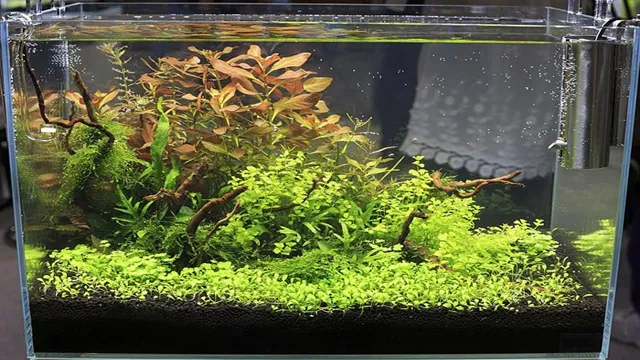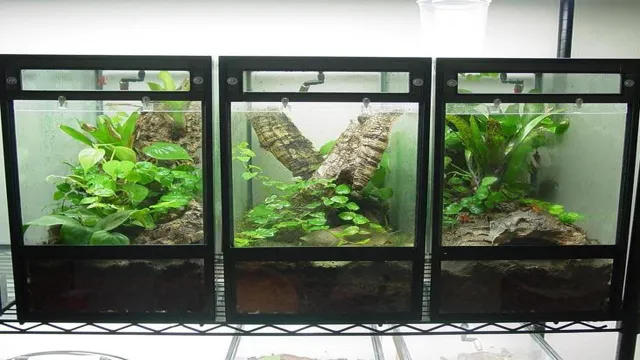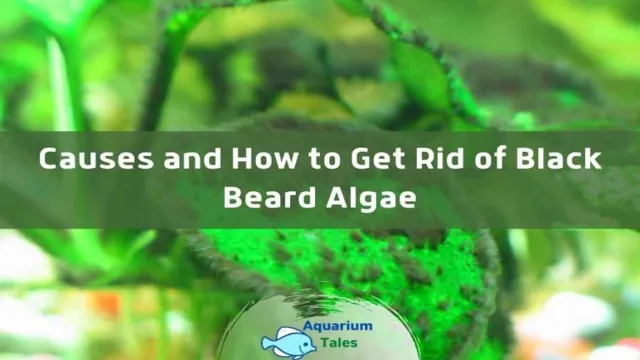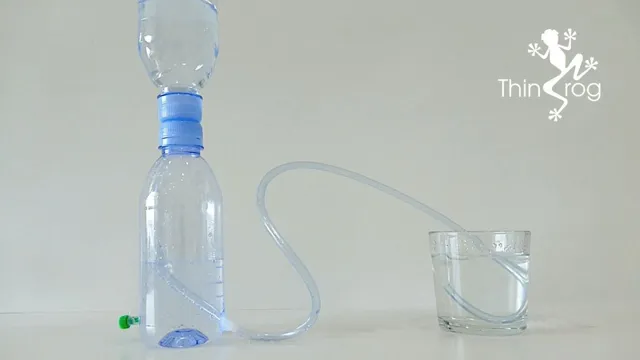Have you tried keeping silk aquarium plants but always struggle to clean them? Do they look dull and covered in green algae? Don’t worry, you’re not alone. Cleaning silk aquarium plants can be a tedious and tricky task. But fear not, there’s a natural solution to keep your plants looking fresh and new.
Vinegar is a fantastic cleaning agent that can do wonders for your silk plants, and it’s eco-friendly too! In this blog post, we’ll explore the benefits of using vinegar to clean your silk aquarium plants and how you can do it without damaging them. Let’s dive in and learn more about the magic of vinegar!
Why Clean Silk Plants?
If you’re wondering why you should clean your silk aquarium plants, there are a few good reasons. First, dust and debris can accumulate on the plants, making them look old, dingy, and uninviting. Additionally, dirty plants can disrupt the balance of your aquarium by releasing harmful toxins when they are disturbed.
To keep your aquarium looking its best and avoid any potential harm to your fish, it’s essential to clean your silk plants regularly. One effective way to do this is to use a solution of vinegar and water. Simply mix a half-cup of vinegar with a gallon of water, soak the plants in the solution for a few minutes, then rinse them thoroughly with warm water.
This will remove any buildup and odors, leaving your silk plants looking fresh and new again. So next time you notice your silk plants starting to look a bit grimy, remember the benefits of cleaning them and give them a good vinegar bath.
Removes Algae Build-up
Silk plants are a great alternative to live plants as they require little maintenance and add a pop of greenery to any space. However, it’s important to remember that even though they are not real, they still need to be cleaned. One of the biggest reasons to clean silk plants is to remove algae build-up.
Algae can grow on the surface of silk plants if they are not cleaned regularly, especially if they are placed in areas with high humidity or moisture. Not only does algae make the plants look dull and dirty, but it can also impact their overall lifespan. By removing algae build-up, you can keep your silk plants looking their best for longer.
So the next time you dust your furniture, don’t forget to give your silk plants a wipe-down too.

Improves Aesthetics
When it comes to decorative plants, silk plants have become a popular choice for many people due to their lifelike appearance and low maintenance requirements. However, like any decorative item, silk plants require regular cleaning to maintain their beauty. One of the primary reasons to clean silk plants is to improve their aesthetics.
Over time, dust and dirt accumulate on the leaves and petals of silk plants, causing them to lose their shine and color. Regular cleaning using a soft cloth or dusting tool helps to remove this build-up of dirt, resulting in silk plants that look fresher, brighter, and more vibrant. Keeping your silk plants clean not only enhances their aesthetics but also helps to prolong their lifespan, making them a more cost-effective and sustainable choice for home décor.
So, be sure to give your silk plants some TLC regularly and enjoy the benefits of their beauty all year round.
The Benefits of Vinegar
If you’re looking for an effective and affordable way to clean your silk aquarium plants, look no further than vinegar! Vinegar is a versatile household cleaner that can be used for a variety of cleaning tasks, including removing dirt, grime, and algae from silk aquarium plants. Simply mix equal parts water and vinegar, soak your plants in the mixture for 10-15 minutes, and then rinse well with warm water. Vinegar is a natural, non-toxic solution that is safe for your plants, as well as for the fish in your aquarium.
Plus, it’s easy to find at your local grocery store and won’t break the bank. Say goodbye to dirty silk plants and hello to a clean and healthy aquarium with the power of vinegar.
Natural Disinfectant
When it comes to cleaning and disinfecting our homes, most of us rely on chemical-laden products that can be harmful to our health and the environment. However, there is a simple and natural solution that has been used for centuries: vinegar. Vinegar is a powerful disinfectant that can kill germs and bacteria, including those that cause foodborne illnesses and respiratory infections.
One of the main benefits of vinegar is that it is safe to use around children and pets, unlike many commercial cleaners that contain harsh chemicals. Additionally, vinegar is readily available and affordable, making it a great option for those on a budget. To use vinegar as a disinfectant, simply mix equal parts of water and vinegar in a spray bottle and use it to clean and sanitize surfaces. (See Also: How to Clean Aquarium Pump with Vinegar: A Step-by-Step Guide)
You can also add essential oils such as tea tree or lavender to give it a pleasant scent. With vinegar, you can have a clean and healthy home without the worry of harmful chemicals.
Breaks Down Residue
Vinegar is not only a versatile ingredient in cooking but also a powerful cleaning solution. Its acidic nature helps break down residue and eliminate tough stains, making it a great natural alternative to harsh chemicals. When used in the kitchen, vinegar can be used to clean appliances, sinks, and countertops, leaving a shiny and streak-free finish.
It can also be used to remove odors from the fridge or microwave. Beyond the kitchen, vinegar can be used to clean windows, tiles, and even your showerhead. The best part? It’s cheap and readily available in most households.
So next time you need to clean something, why not give vinegar a try? You might be surprised at how effective it can be.
How to Clean Silk Aquarium Plants with Vinegar
Silk aquarium plants can add a touch of elegance to your fish tank, but over time they can accumulate algae and other debris. One effective way to clean silk aquarium plants is by using vinegar. First, remove the plants from the tank and rinse them thoroughly with water.
Then, mix a solution of 1 part vinegar and 3 parts water in a bowl or container. Place the plants in the solution and let them soak for at least 15 minutes. You can also use a soft-bristled brush to gently scrub the plants to remove any stubborn stains.
When finished, rinse the plants thoroughly with water to remove any vinegar residue. Vinegar is a natural and safe cleaning agent for silk plants, and it can also help to disinfect and deodorize them. Just remember to avoid using vinegar on live plants or any decorations made of limestone, marble, or other sensitive materials.
With a little bit of patience, your silk aquarium plants will look as good as new!
Step 1: Prepare Vinegar Mixture
If you’re looking to keep your aquarium plants clean and healthy, vinegar can be a great natural solution. Start by preparing your vinegar mixture. You can use white vinegar or apple cider vinegar for this.
Mix one part vinegar with four parts water in a spray bottle. Shake the bottle to ensure it’s well mixed. Be sure to use a spray bottle that’s labeled for use with chemicals to ensure it won’t be damaged by the vinegar mixture.
Once the mixture is ready, move on to the next step in cleaning your silk aquarium plants. The vinegar mixture will help to remove any built-up grime or algae, giving you a fresh and vibrant plant for your aquatic environment. So, give it a try, and see the difference it can make!
Step 2: Soak Silk Plants
When it comes to cleaning silk aquarium plants, vinegar can be a game-changer. However, before applying vinegar, it’s important to soak the plants in water first. Why? Well, because silk plants tend to accumulate dust and dirt.
Soaking them will loosen up any debris or dirt that may have stuck to the surface. Once the plants are fully submerged, add some vinegar to the water and let them soak for a few hours. The vinegar will help to remove any stubborn stains or build-up that may have been left behind.
Plus, vinegar is a natural disinfectant, so it will kill any bacteria or microbes that may be present. Once they’re done soaking, rinse the plants thoroughly with water to remove any remaining vinegar. Now you have clean and sanitized silk plants for your aquarium! (See Also: How to Make an Aquarium Snail Trap: A Step-by-Step Guide to Catching Pesky Snails in Your Tank)
Step 3: Rinse and Dry
If you’re wondering how to clean your silk aquarium plants without damaging them, vinegar is a safe and effective solution. To get started, mix equal parts white vinegar and water in a bowl. Take each silk plant out of your aquarium and place it in the solution, making sure it’s fully submerged.
Allow the plants to soak for around 15-20 minutes, then gently remove them from the bowl. Use a soft brush or cloth to gently wipe away any remaining debris or dirt from the leaves and stems. Once you’ve finished cleaning each plant, rinse them thoroughly under cold running water to remove any traces of vinegar.
Then, lay them flat on a clean towel or paper towel to dry completely before returning them to your aquarium. This method is gentle enough to keep your silk plants looking clean and vibrant for a long time.
Precautions and Tips
When it comes to cleaning silk aquarium plants, vinegar is a powerful ally. However, it’s important to take some precautions to protect the delicate fabric. Before cleaning, make sure to remove any debris and rinse the plants thoroughly with water.
Then, create a solution of one part vinegar to three parts water in a spray bottle. Spray the solution onto the plants and let it sit for a few minutes to loosen any grime. Gently scrub the surface using a soft-bristled brush or cloth, then rinse again with water.
It’s important not to twist or wring the silk plants as this can damage the fabric. Finally, allow the plants to air dry completely before placing them back in the tank. With these tips in mind, cleaning your silk aquarium plants can be a breeze!
Avoid Harmful Chemicals
When it comes to avoiding harmful chemicals, there are several precautions and tips that you can follow to ensure that you are keeping yourself and your loved ones safe. The first thing to keep in mind is to always read the labels of the products that you are using. Look for products that are labeled “non-toxic” or “all-natural” to avoid exposure to harmful chemicals.
Additionally, be aware of the chemicals that are commonly found in household cleaning products, such as bleach and ammonia. Consider switching to natural alternatives, such as vinegar and baking soda, which are just as effective and safe to use. Another important tip is to properly store your cleaning products and other chemicals, keeping them out of reach of children and pets.
By taking these simple precautions, you can protect yourself and your family from the harmful effects of chemicals in your home.
Avoid Abrasive Cleaning Tools
When it comes to cleaning, many of us want to get the job done as quickly as possible. However, it’s important to take precautions, as using abrasive cleaning tools can cause damage to surfaces and objects, and in some cases even be dangerous. Some of the most common abrasive cleaning tools include steel wool, abrasive sponges, and scouring pads.
Not only can these scratch and damage surfaces, but tiny metal particles from the steel wool can also become embedded in surfaces and lead to rust. To avoid this, it’s best to opt for non-abrasive cleaning tools, such as microfiber cloths, soft-bristled brushes, and gentle cleaning solutions. Not only will this help to protect your surfaces and objects, but it will also make your cleaning routine more efficient in the long run.
Remember, taking the time to use caution and choose the right tools will pay off in the end, and keep everything looking its best.
Regular Cleaning Maintenance is Key
Regular cleaning maintenance is a key part of keeping your home or office in top shape. However, it’s important to take precautions during your cleaning routine to avoid accidents or damaging items. One of the most important tips is to read the labels on cleaning products before using them to ensure they’re compatible with the surfaces you will be cleaning. (See Also: How to Clean Calcium off Aquarium Glass: 7 Simple Steps for Spotless Tanks)
For instance, harsh chemicals meant for the bathroom might not be safe for your wooden floors. Another precaution is to use protective gear such as gloves and goggles to avoid skin irritation or eye damage. These small steps will not only help keep you safe but also help preserve the quality of your home or office.
So don’t skimp on taking the right precautions to keep your space clean and well-maintained. By doing so, you’ll save yourself time and money in the long run.
Conclusion
In conclusion, cleaning silk aquarium plants is no longer a difficult task, thanks to the wonders of vinegar! By utilizing this versatile household staple, you can easily and effectively clean and refresh your silk plants, leaving your aquarium looking pristine and healthy. Just mix a small amount of vinegar with water, gently scrub your plants, rinse them thoroughly, and voila! You’ll have a sparkling clean aquarium that even your fish will appreciate. So say goodbye to grime and hello to a cleaner, safer environment for your aquatic pets with vinegar as your trusty cleaning ally.
It’s safe, natural, and most of all, it works like a charm!
FAQs
Can I clean silk aquarium plants with vinegar?
Yes, you can clean silk aquarium plants with vinegar, as it is a natural and safe cleaning agent that won’t harm your plants or harm aquatic life.
How do I clean silk aquarium plants with vinegar?
To clean silk aquarium plants with vinegar, you can mix equal parts of vinegar and water in a spray bottle, and spray the solution onto your plants. Let it sit for 5-10 minutes, then rinse the plants thoroughly with water.
Is vinegar safe for my aquarium fish?
Yes, vinegar is safe for aquarium fish, as long as it is diluted properly and no vinegar is left on the plants when they are returned to the aquarium.
How often should I clean my silk aquarium plants with vinegar?
It is recommended to clean your silk aquarium plants with vinegar every four to six weeks, or as needed.
Can I use vinegar to clean other aquarium decorations?
Yes, you can use vinegar to clean other aquarium decorations, such as rocks and ornaments, as long as they are rinsed thoroughly with water before being returned to the aquarium.
What are the benefits of using vinegar to clean silk aquarium plants?
Using vinegar to clean silk aquarium plants is a natural and safe way to remove algae and other buildup, without the use of harsh chemicals that could harm aquatic life. Vinegar is also an effective cleaning agent that can help keep your aquarium plants looking their best.
What should I avoid when cleaning silk aquarium plants with vinegar?
When cleaning silk aquarium plants with vinegar, it is important to avoid using undiluted vinegar, leaving vinegar on the plants, or using abrasive materials that could damage the plants.







